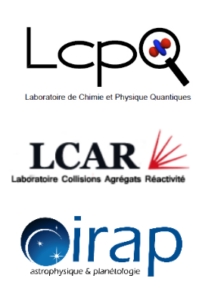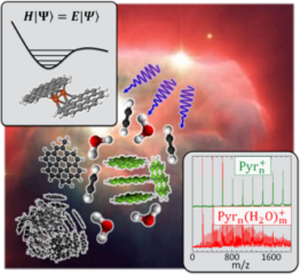Research project selected under the 2021 call for proposals

Principal Investigator : Aude Simon
Involved Teams :
- LCPQ / Modeling, Aggregates, Dynamics group
- LCAR / Cluster group
- IRAP / Interstellar Medium, Cycle of Matter, Astro-Chemistry team
Type of project : Collaborative Project
Date (start/end) : 2021 – 2024

The MIRRADOR project aims at quantifying adsorption and thermal desorption processes, as well as the reactivity, of small molecules of
astrophysical interest (H2O and C2H2) on large carbonaceous molecules such as polycyclic aromatic hydrocarbons (PAHs) and their clusters. The considered PAHs can be regular or chemically modified e.g. dehydrogenated, possessing aliphatic groups or complexed with Fe atoms, such alterations being expected to modify the reactivity. Their clusters are good candidates for astrophysical very small grains (VSGs) and the study of their physical-chemical properties will find applications in models of regions of stellar and planetary formation. This project is a collaborative project between one theoretical team (LCPQ) and two experimental teams (LCAR and IRAP) that will bring state-of-the-art complementary approaches in order to obtain quantitative data such as sticking and desorption efficiencies as a function of temperature and of the nature of the VSGs and to investigate reaction mechanisms involving these systems. Experiments using the aggregation cluster source developed by LCAR will be performed to measure the sticking efficiency of H2O onto size-selected pyrene clusters (C16H10)n+ (n<20) and investigate the thermal desorption of water from (C16H10)n+ (H2O)m+. They will be complemented by collision induced dissociation experiments to measure dissociation energies. Similar studies replacing H2O by C2H2 are also planned. In addition, reactivity experiments will be performed using cryogenic trapping setups (PIRENEA and PIRENEA 2 developed by IRAP) in order to explore (photo)-reactions of chemically modified PAH+ and their clusters with H2O and C2H2. The PIRENEA2 setup will be used to produce mixed PAH-Fe complexes using a laser vaporization source. In addition, it will be equipped with the aggregation cluster source of LCAR to generate PAH clusters. Oxidation reactions are expected to be observed in the case of H2O while C-C coupling leading to hydrocarbon growth is expected in the case of C2H2. The modelling of these adsorption, desorption and reactive processes will be achieved at LCPQ. Molecular dynamics simulations with a quantum description of the electronic structure at the DFT and DFTB (Density Functional based Tight Binding ) levels of theory will be used to provide a deep understanding of the involved chemical and physical processes.
MIRRADOR aims at providing new insights into the chemical and physical properties of molecular clusters containing PAHs and producing new data to be used in chemical modelling of astrophysical environments.
